
Mini Monstera
$37
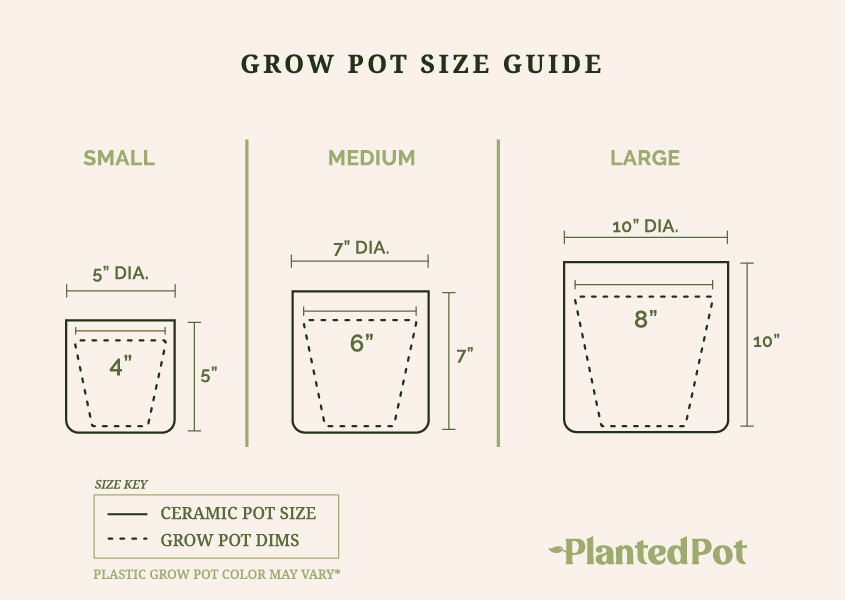 Plastic grow pots come in different colors, you may receive a black or rust colored pot.
Plastic grow pots come in different colors, you may receive a black or rust colored pot.
Meet the Monstera Minima, the little cousin of the wildly popular Monstera Deliciosa. Everything we love about the Deliciosa has been shrunken down into a charming and easy-to-manage plant you can put anywhere. The Monstera Minima is incredibly easy to care for, requiring weekly waterings and a slightly humid environment. Live in a dry area? No problem! Simply mist the plant’s leaves regularly to keep it healthy, vibrant, and stunning. Grab yours today to see why great things come in small packages!
Ideally, bright but indirect filtered light, can cope with lower light too. Protect from harsh sun which can scorch the foliage
Keep soil moist using water at room temperature, but do not allow the plant to sit in water. Aerate the soil before watering
Will grow happily in temperatures of 12-27°C, try to avoid sudden drops in temperature and be wary of draughts and open windows.
Related Products
Mini Monstera
Nowadays, it is incredibly common to see homes with plenty of houseplants. Whether you have gardening experience or not, having a Mini Monstera as an indoor plant will bring you plenty of joy and keep your house looking great. Mini Monsteras are easy to care for, and you will find yourself wanting more than just one.
This rare plant can transform your living room into a mini tropical getaway. As long as you can meet this plant’s care requirements, you will have a green friend to keep you company. If you want to learn more about Mini Monstera, read on further!
What is a Mini Monstera?
Although they are nicknamed Mini Monsteras, this tropical vine plant’s actual botanical name is Rhaphidophora Tetrasperma. This plant is commonly misidentified due to its other nicknames:
- Mini Monstera Deliciosa (also known as Mini Swiss Cheese Plant)
- Monstera Rhaphidophora Tetrasperma
- Monstera Minima
- Philodendron Ginny
- Philodendron Piccolo
Each of these plants shares similarities with the Rhaphidophota Tetrasperma but are all different plants. Monstera, Philodendron, and Rhaphidophora plants belong to the Araceae family but are their separate genera. Throughout this article, we will refer to this plant as the Mini Monstera, its most popular nickname.
The Mini Monstera is a flowering plant native to Thailand and Malaysia discovered in 1893 by a British botanist. It has aerial roots to attach itself to trees in the wild or a moss pole in a pot. The roots allow it to climb or hang off surfaces for stabilization.
The green leaves are heart-shaped and recognizable by the large splits, which resemble swiss cheese. The splits in the leaf are known as fenestration. The Mini Monstera does not produce fruit but is capable of blooming very tiny flowers in the wild.
Below are some quick care tips for the Rhaphidophora Tetrasperma Plant.
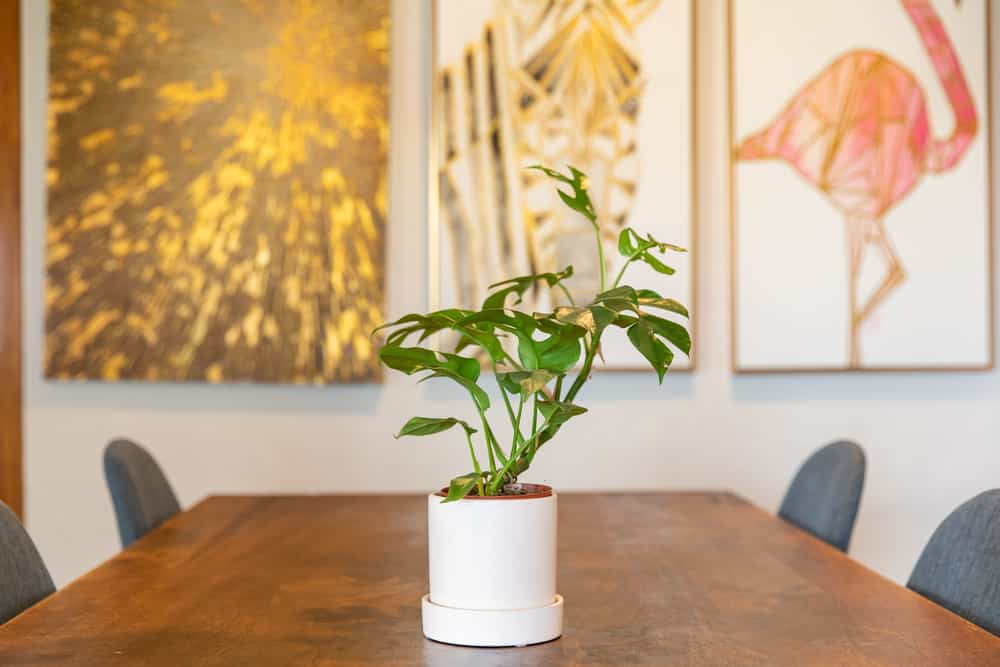
Mini Monstera Plant Size
In the wild, this plant can grow up to 16 feet. It can also reach this height as an ornamental plant after a couple of years, but most plant parents keep it four to five feet tall indoors. The leaves are approximately six inches long and four inches long. Aside from height, the plant can also spread out horizontally.
Light Needed for a Mini Monstera
Mini Monsteras thrive best under bright indirect light. Overexposure to direct sunlight can cause discoloration and scorch the leaves. It can handle low light conditions as well but at the expense of slowing down growth.
How Often to Water a Mini Monstera Plant
Stick your finger in the soil to see how moist it is. After allowing the soil to dry out completely, water this plant either once or twice a week, depending on the seasons (water less during the winter). Keep a watering schedule to prevent overwatering or underwatering, which can both affect the plant’s health.
Safe Temperatures Mini Monstera Plants Thrive In
This hardy plant can handle temperatures between 55 to 85 degrees Fahrenheit. The Mini Monstera Plant enjoys humid conditions that are reminiscent of its native habitat. Misting the leaves helps increase the moisture in the air surrounding your plant.
Why Choose a Mini Monstera Plant?
There are many reasons to choose a Mini Monstera Plant outside of the fact that it is a gorgeous plant. According to professional botanists, some plants are more common than others, but Mini Monsteras are rare plants in nature. You can impress your friends and other plant owners by having one of these plants on display at your home.
Here are a few other reasons why you should own this plant.
- Stress Reliever: Having a houseplant can help ease the nervousness that occurs throughout the day. Studies have shown that interacting and working with a plant can help provide a mental state of tranquility. You will feel a sense of accomplishment for being able to care for your Mini Monstera and see its growth!
- Boosts Mental Clarity: Brain fog is common, affecting how well you can focus or remember something. Researchers have discovered that interacting with a houseplant can provide you with mental clarity.
- Low Maintenance: Monsteras are so popular because they are easy to for. These are hardy plants that cost next to nothing to maintain.
This lovely plant is a perfect gift for a coworker or housewarming present for a new home. It will make a great decorative plant, no matter if it’s indoors or outside.
Are Mini Monstera Plants Good Indoors & Outdoors?
Most plants of this species are houseplants, but not all plants can do both — indoor and outdoor. Even though the Rhaphidophora Tetrasperma is an excellent indoor plant, it’s originally in nature. The Mini Monstera is capable of living outdoors as long as certain conditions are met.
Here are some tips to consider if you want to keep this plant indoors or outdoors:
- Weather Conditions: Although they are native to Southeast Asia, the Rhaphidophora Tetrasperma can only be kept outside all day if you live in hardiness zone 9b to 12. This area includes parts of the Southwest United States and the Florida Peninsula. This plant responds well to average room temperatures and humidity levels instead of outdoors, where it is more susceptible to extreme weather damage.
- Plant Pests: Spider mites are parasitic bugs that suck the nutrients out of your plants’ leaves. Spider mites are attracted to live plants in warm weather conditions. If you notice yellowing leaves or white webs on your plant, it is likely a sign of a spider mite infestation.
- Soil: Whether you keep it indoors or outside, your Mini Monstera Plant will benefit from growing in a well-drained potting mix. You can provide your houseplant a nitrogen-rich fertilizer during the growing season in spring to provide it with nutrients and encourage its growth.
- Propagation: Instead of deciding whether to keep your Mini Monstera indoors or outside, you can take a cutting and grow it into separate plants indoors and outside. The cutting should include a node and aerial roots grown into water or a potting mix.
Outdoor greenhouses are a great environment for growing your Rhaphidophora Tetrasperma plant. You can also freely move your potted plant outdoors in the shade and good light source. At night when the weather cools down, you can bring it indoors overnight.
Are Mini Monstera Plants Pet and Children Friendly?
Mini Monstera plants are eye-pleasing to look at but are not meant to be eaten by pets and people. This plant is mildly toxic and causes temporary side effects such as nausea, vomiting, and minor skin irritations.
It is natural for little kids, dogs, and cats to have a curious mind and grab at random things to much on. Keep your pets and small children in mind when finding an area to place your plant in.
If ingested and the side effects do not subside, consult with a medical professional for further diagnosis.
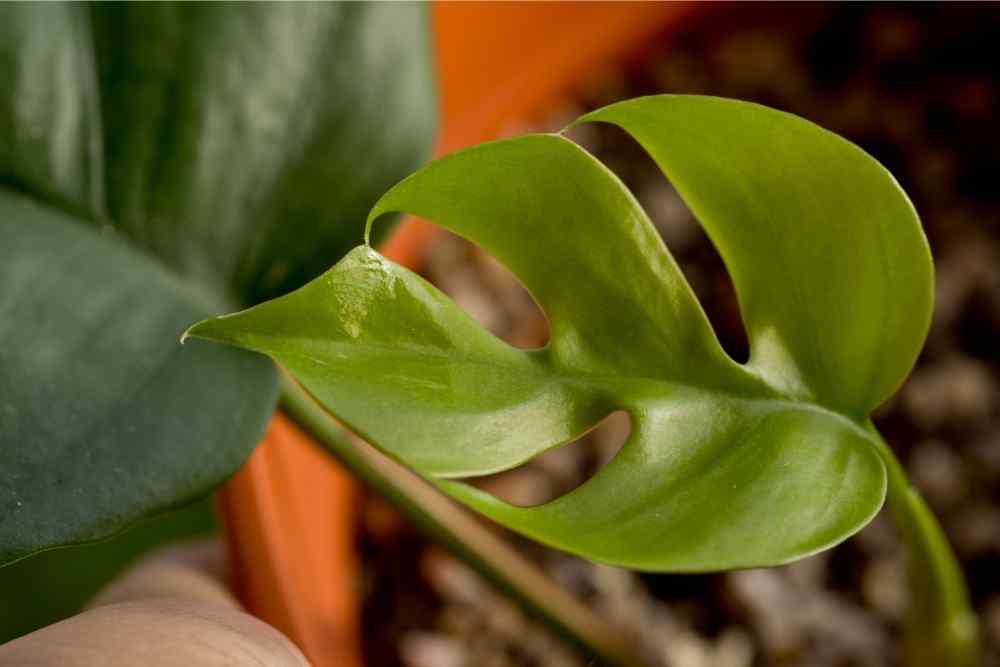
Mini Monstera Family Relatives
The Araceae family, which the Rhaphidorphora Tetrasperma is part of, contains over 3500 species of plants. Some are more popular than others, but they all have similar care requirements as the Mini Monstera.
Here are some Mini Monstera family relatives:
- Swiss Cheese Plant (Monstera Deliciosa): Native to the jungles of Mexico and other parts of Latin America, the Monstera Deliciosa has large leaf holes in it. It can produce edible fruits in the wild. The evergreen leaves are also heart-shaped.
- Philodendron: One of the best starter plants for inexperienced plant growers, the Philodendron can grow like a vine and bring a tropical vibe to your home. There are different varieties of the Philodendron that come in different colors and leaf shapes.
- Swiss Cheese Vine (Monstera adansonii): Like the Monstera, this plant has swiss-cheese-like green leaves. Instead of staying settled in a pot, this plant can also grow like a vine. The Monstera adansonii will look especially good when paired with your Mini Monstera!
Plants That Are Similar to the Mini Monstera
The great thing about starting a houseplant connection is that there are hundreds of plants to choose from. These are some plants similar to the Mini Monstera:
- Golden Pothos: Also known as Devil’s Ivy, the Golden Pothos is a trailing vine known for its vibrant waxy leaves. It is a hardy plant that can handle a little neglect from its busy plant parent.
- Pilea Plant (Pilea peperomioides): The Pilea is also a lucky plant! The small green leaves are shaped like coins, which is why many call it the Chinese Money Plant.
- Bird’s Nest Fern: With its glossy green leaves, the Bird’s Nest Fern is another plant to consider for your houseplant collection. The leaves grow in a rosette pattern and resemble seaweed.
Curious about these plants? Well, you’re in luck because Planted Pot is your best source for all these plants and more!
Final Thoughts – Mini Monstera
People may often misidentify the Mini Monstera, but there is no denying how amazing this plant will look inside your home. You do not need years of gardening experience to care for this plant and help it grow into a vine across your home.
If you can care for the Monstera Minima, you will certainly be capable of caring for other houseplants. If you want to check out other plants, browse around our care guides and grab a leafy friend today!
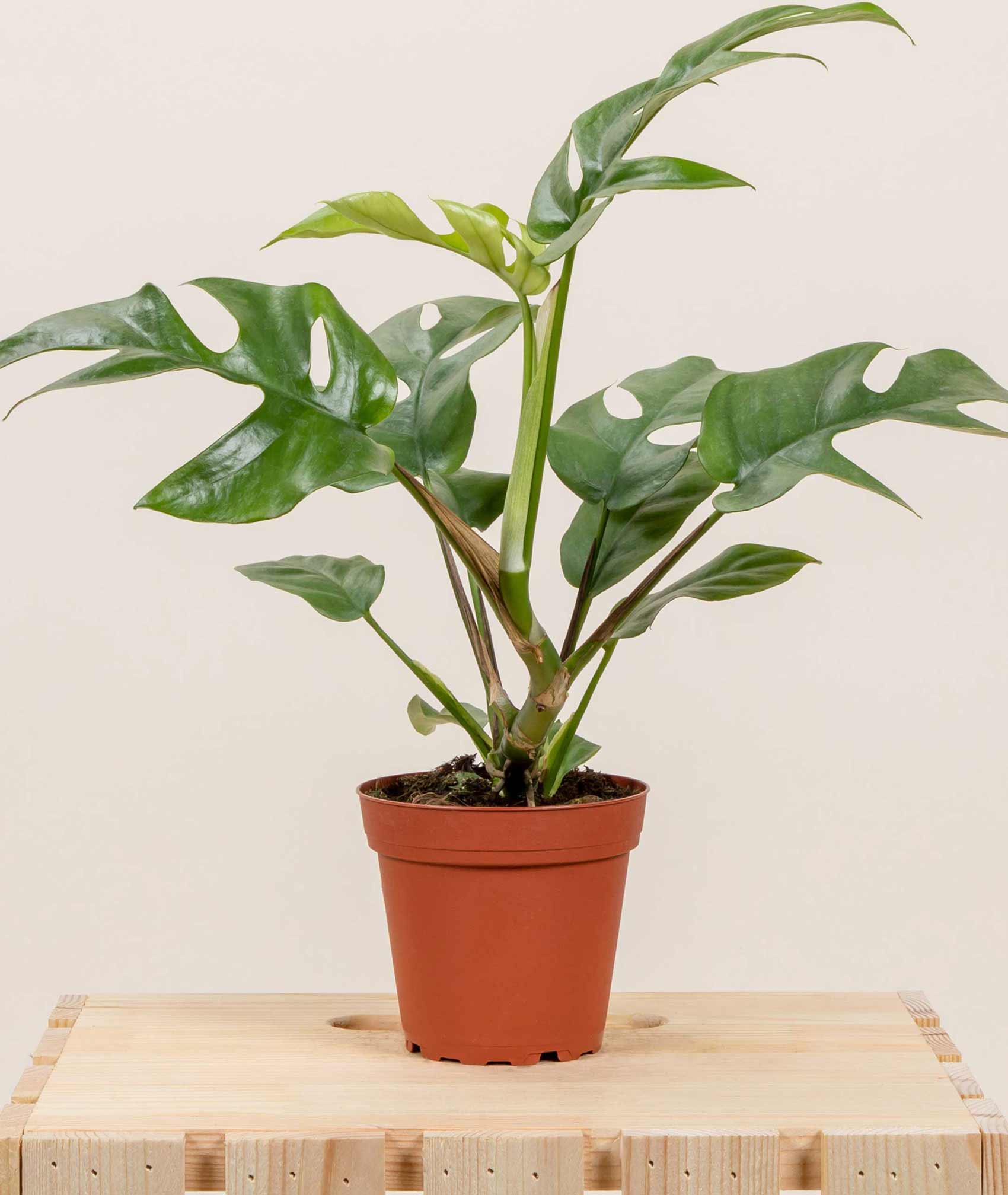
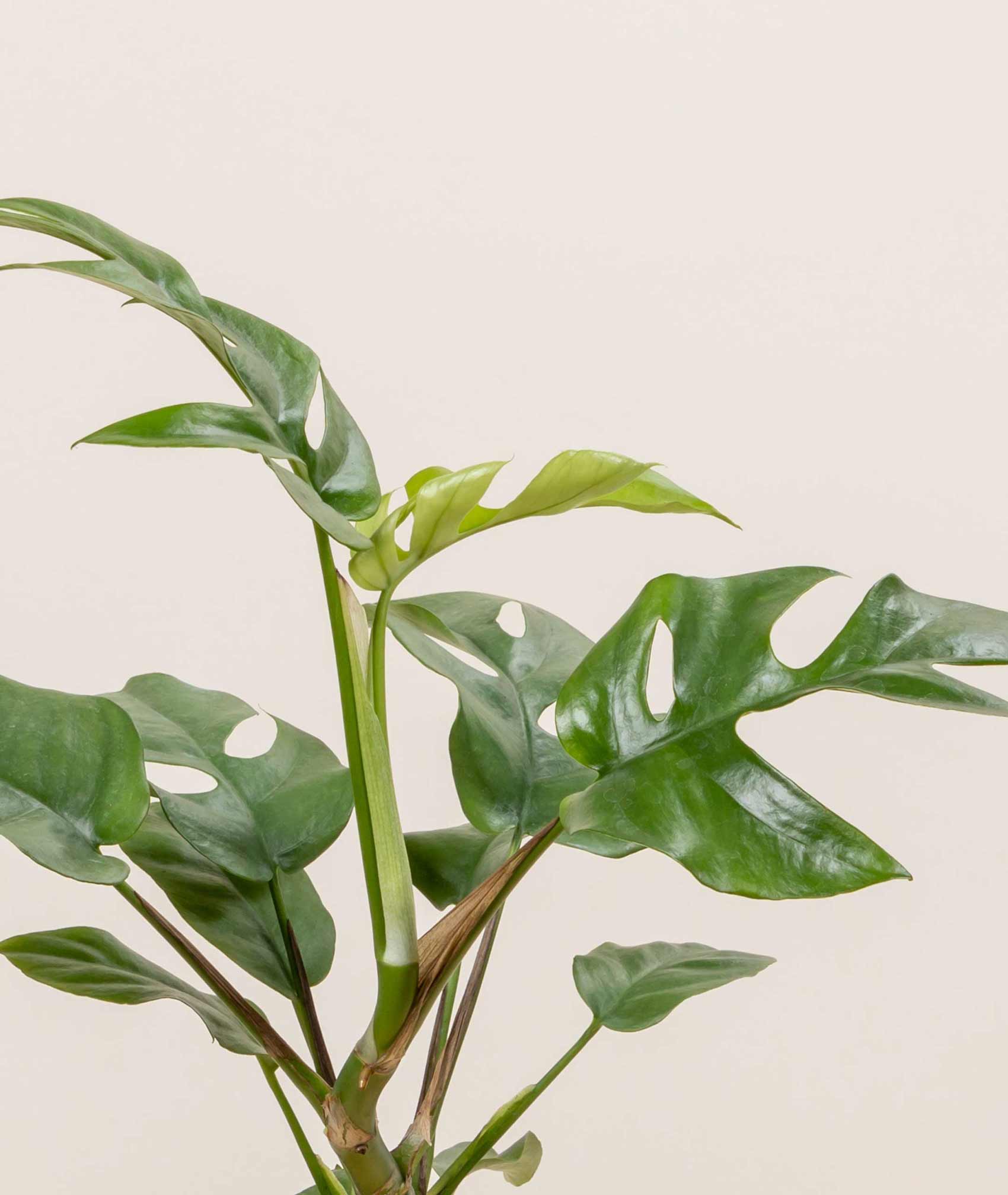



Reviews
There are no reviews yet.